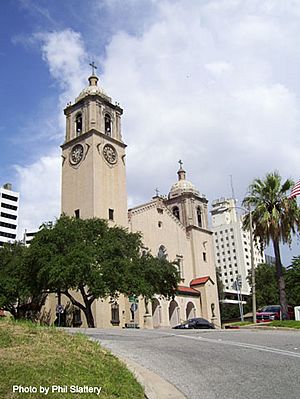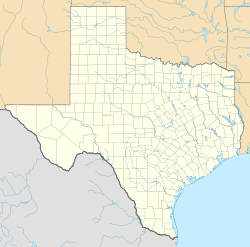Corpus Christi Cathedral (Corpus Christi, Texas) facts for kids
Quick facts for kids Corpus Christi Cathedral |
|
|---|---|
 |
|
| 27°47′40″N 97°23′49″W / 27.79444°N 97.39694°W | |
| Location | 505 North Upper Broadway Corpus Christi, Texas |
| Country | United States |
| Denomination | Roman Catholic |
| History | |
| Status | Cathedral |
| Founded | 1853 |
| Dedicated | 1940 |
| Architecture | |
| Architect(s) | Charles Monot |
| Style | Spanish Colonial Revival |
| Completed | 1940 |
| Construction cost | $425,000 |
| Specifications | |
| Length | 176 feet (54 m) |
| Width | 90 feet (27 m) |
| Height | 133 feet (41 m) |
| Number of domes | Two |
| Dome height (outer) | North tower: 97 feet (30 m) South tower: 125 feet (38 m) |
| Materials | Stucco |
| Administration | |
| Diocese | Corpus Christi |
The Corpus Christi Cathedral is a very important church located in Corpus Christi, Texas, United States. It is called a "cathedral" because it is the main church for the Catholic Diocese of Corpus Christi. This means it's where the bishop of the area has his special chair, or "cathedra."
Contents
History of the Cathedral
The First Church: St. Patrick's
Long ago, in the early days of Corpus Christi, priests had to travel very far to help the Catholic people. There was no church building, so they held church services in people's homes.
In 1853, a priest named Rev. Bernard O'Reilly became the first pastor in Corpus Christi. By 1855, a small church made of adobe (a type of brick made from earth) was being used. The land for this church was given by H. L. Kinney. Many Irish immigrants lived in the area, so the church was named St. Patrick.
Later, in 1874, a new church area called the Vicariate Apostolic of Brownsville was created by Pope Pius IX. The leader, Rev. Dominic Manucy, lived in Corpus Christi. He saw that St. Patrick's Church needed repairs. So, he had a second, larger church built on the same land. This new church was ready in November 1882.
In 1912, St. Pius X created the Diocese of Corpus Christi. St. Patrick's Church then became the main church, or cathedral, for this new diocese. Big hurricanes hit Corpus Christi in 1916 and 1919. St. Patrick's Cathedral helped people who lost their homes during these storms. In November 1938, St. Patrick's Cathedral was damaged by a fire.
Building the New Corpus Christi Cathedral
Before the fire, St. Patrick's Church and the diocese were already growing too big for the old building. After the fire, everyone decided it was time to build a brand new church. John Kenedy donated the land for this new building.
Charles Monot designed the new cathedral. He used a style called Spanish Colonial Revival. This style often features stucco walls, red tile roofs, and decorative elements inspired by old Spanish buildings. The first stone for the new cathedral was placed on March 1, 1940. Bishop Emmanuel Boleslaus Ledvina officially opened it in July of the same year.
Pope Pius XII wanted the new cathedral to be named Corpus Christi. So, when it was opened, its name was changed. The old St. Patrick's buildings were rebuilt and became a different church called Our Lady, Star of the Sea Church.
Size and Features
The Corpus Christi Cathedral is quite large. It is about 53.6 meters (176 feet) long and 27.4 meters (90 feet) wide. It has two towers. The south tower is taller, reaching about 38.1 meters (125 feet) to the top of its dome and 40.5 meters (133 feet) to the top of its cross. The north tower is a bit shorter, rising to about 29.6 meters (97 feet) to its dome and 32 meters (105 feet) to its cross.
Changes Over Time
In the 1960s, Bishop Thomas Joseph Drury had the cathedral updated. These changes were made to fit new ways of worship that came from the Second Vatican Council. Later, a special concert series started at the cathedral. The church also began to work with other community groups.
In 1979, a small chapel was built in the lower part of the cathedral for daily services. A new building for the priests, called a rectory, was also built. The cathedral was updated again in 1980. In the 1980s, church services from the cathedral began to be shown on television every week.
See also
 In Spanish: Catedral de Corpus Christi (Corpus Christi) para niños
In Spanish: Catedral de Corpus Christi (Corpus Christi) para niños


